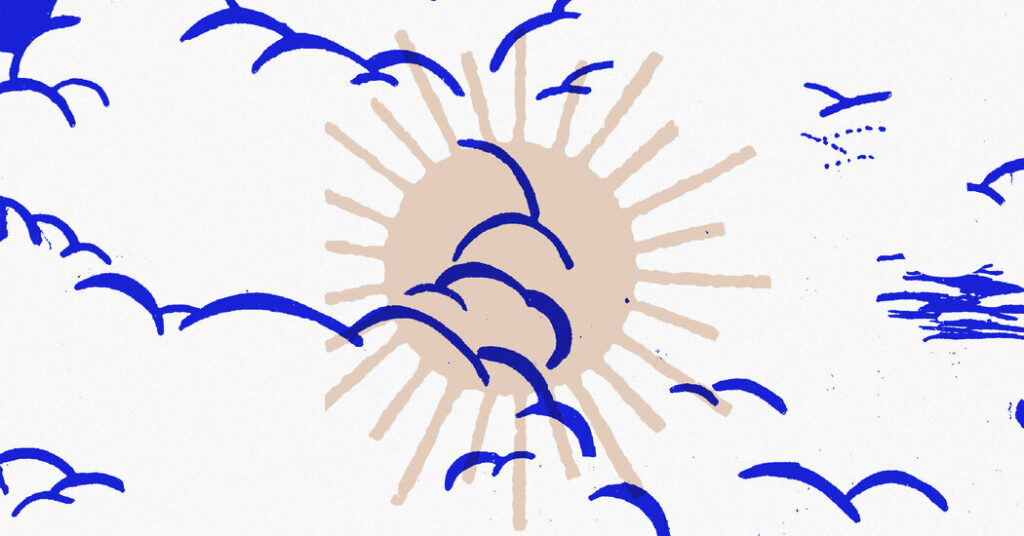Opinion | The Only Positive of Smokemageddon
6 min read
The rivers of smoke pouring into the United States from Canadian wildfires have lowered temperatures by blocking sunlight from reaching the ground. The unseasonable coolness hasn’t gotten as much attention as the smoke. It may be the only positive aspect of Smokemageddon (or whatever the TV weather forecasters are calling this).
Imagine if the opposite happened and wildfires typically raised surface temperatures. The extra heat could dry out forests and cause even more wildfires to break out. That would be a disastrous feedback loop.
“It’s reassuring that there’s not going to be a positive feedback” from forest fires to smoke to more forest fires, Michael Fromm, a meteorologist for the Naval Research Laboratory in Washington, told me on Thursday.
That said, there’s still a lot that’s unknown about the effects of wildfires, which are becoming more common as the planet heats up. Fromm told me that wildfires haven’t yet been incorporated into the giant computer models that are used to forecast climate change. One reason, apart from the uncertainty about the science, is that even large wildfires are mere pinpricks on the surface of the planet, much smaller than, say, the jet stream.
“Small features like that are usually washed out,” he said, “even though they have an outsize impact.” He said “there is increasing momentum” to work wildfires into climate models. That’s good.
Meteorology and climate science are a little like macroeconomics, which I’m more familiar with. Both involve using computer models to predict the behavior of complex systems whose bits and pieces (molecules, people) interact in ways that aren’t fully understood. Economists try to supply microfoundations for their forecasts by tying macro-level phenomena to individual-level behaviors. Meteorologists and climate modelers do something similar. No one has been fully successful.
I learned a lot about wildfire smoke on Thursday, aside from the fact that it turns the sky orange and stings the eyes.
In the 1990s, Fromm told me, Naval Research Laboratory satellites detected smoke in the stratosphere. It appeared to have come from forest fires in Canada and eastern Russia. It surprised them because meteorologists had believed that the only materials that could reach the upper atmosphere were ash and sulfate droplets from volcanoes. Fromm led a team of nine scientists who wrote up the findings in Geophysical Research Letters in 2000.
The next question was: How was it getting into the stratosphere? Most weather is confined to the troposphere, the lower part of the atmosphere. In the following years, scientists discovered that the wildfires were so powerful, they generated their own thunderstorms, which became chimneys to the stratosphere. These were pyrocumulonimbus clouds whose lofty, anvil-shaped tops reached higher than the flight paths of jet aircraft, past the boundary between the troposphere and the stratosphere.
“When fires initiate or intensify towering thunderstorms, they can inject aerosols into the lower stratosphere that were once thought to originate only from volcanic plumes,” Fromm and seven other scientists wrote in a review article in 2010 for The Bulletin of the American Meteorological Society, “The Untold Story of Pyrocumulonimbus.”
Wildfire smoke that reaches the stratosphere travels farther and lasts longer than low-level smoke. Some of the smoke over North America now is from older fires and has already traveled once around the world.
There are differences between wildfire smoke and volcanic plumes. The sulfate droplets that volcanoes produce reflect sunlight away from Earth. The explosion of Indonesia’s Mount Tambora, for example, made 1816 “the year without a summer” in North America and Europe. The black and brown carbon particles from wildfires absorb heat more than sulfate droplets do. They still keep solar radiation from reaching Earth’s surface, but the overall cooling effect is weaker. Plus, big wildfires are smaller than big volcanoes (although two of the five biggest stratospheric impacts since 2011 have come from outbreaks of wildfire-induced thunderstorms).
There have been more than 30 pyrocumulonimbus thunderstorms in Canada this fire season, far more than usual, David Peterson, who works out of the Naval Research Lab in Monterey, Calif., and maintains a database of the storms, told me. They are powerful and scary. Check out this New York Times article for a video and a computer animation of a pyrocumulonimbus that formed over the Dixie fire in California in 2021.
The smoke that’s blocking the sun over parts of the northern United States right now is coming in at several levels. Some is near the ground, and some is in the stratosphere. The carbon particles that reach the stratosphere tend to be bigger, but scientists don’t fully know what to make of that yet. Data is scarce. A DC-8 jet flew through a pyrocumulonimbus cloud to gather data for the first time in 2019 on a mission run by NASA and the National Oceanic and Atmospheric Administration, Peterson said.
“There is a small and very enthusiastic community of scientists that track these day to day,” Robert Field, a research scientist at NASA’s Goddard Institute for Space Studies, told me.
Wildfires are bad news in many ways, aside from their damage to people, structures, and plants and animals. Smoke particles can erode the ozone layer. Also, by absorbing solar energy, wildfire smoke can change local patterns of wind and rainfall in a way that “increases air pollution exposure and accelerates wildfire expansion,” a study published in February in the journal Science found. And if the soot from a wildfire lands on snow and ice, it makes them absorb more heat and melt faster. And of course, the combustion of trees and bushes produces greenhouse gas emissions that contribute to long-term global warming.
But at least the smoke that wildfires produce — the stuff that has darkened skies across much of the northern United States — doesn’t appear to be accelerating the heating up of the planet.
Elsewhere: The Sun Belt Is Up, and So Is Cleveland
“Pandemic migration trends are not reversing,” and Sun Belt cities are continuing to gain population at the expense of some of the nation’s biggest metro areas, the Bank of America Institute said in a report released Monday. The report uses the bank’s data on its customers to estimate population changes and is more up-to-date than what’s available from the Census Bureau.
One surprise: Cleveland broke into the list of fastest-growing metros, right between Orlando, Fla., and Dallas. Anna Zhou, an economist for the Bank of America Institute, wrote in an email that Cleveland benefits from relatively affordable housing and a diversified economy: It has health care, finance and manufacturing, all of which are doing well. Baiju Shah, the president of the Greater Cleveland Partnership, told me that the metro region also benefits from positive word of mouth about its cultural amenities and “ease of life.”
The Readers Write
Concerning the merger of the PGA Tour with LIV Golf: We tolerate monopolies in other professional sports, why not golf?
Elliott Dubin
West Springfield, Va.
When I read that a Nobel laureate economist had stated that incentives are absent from psychology, I immediately pictured B.F. Skinner rolling in his grave. Anyone who makes this sort of claim, which blatantly ignores operant conditioning (among other concepts in psychology), needs to take a Psych 101 class.
Holly Sorenson
Mount Kisco, N.Y.
Quote of the Day
“I hope that we will join other social sciences and accept that race is a social construct. The purpose of the construct is to have a dominant group designate a group to receive less of the goods of society.”
— William Spriggs, the chief economist of the A.F.L.-C.I.O., in an open letter to fellow economists after the police killing of George Floyd (June 9, 2020). Spriggs died on Tuesday.
Peter Coy has covered business for more than 40 years. Email him at [email protected] or follow him on Twitter. @petercoy
Source: Read Full Article






